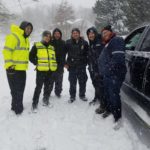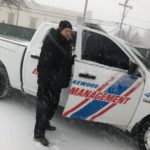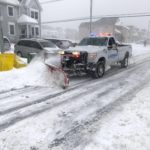Protect Yourself Before, During, and After a Winter Storm
1 | BEFORE: PREPARE
Prepare now in case a winter storm hits and you are
home for several days without power and heat.
• Prepare by gathering emergency supplies, making a family plan, and discussing emergency notifications and expectations with your workplace and/or schools.
• Install battery-powered or battery back-up carbon monoxide detectors.
• If you have access to an OUTSIDE generator, have an electric cord long enough to keep the generator at least 20 feet from any door, window, or vent.
• Make specific plans for how you will avoid driving.
• Be alert to changing weather conditions using local alerts, radio, and other news sources for information and instructions.
2 | DURING: SURVIVE
Stay indoors and avoid driving as much as possible.
• If the power goes out, close off unused rooms to consolidate and retain heat.
• Wear layered clothing and use blankets or sleeping bags to stay warm.
• Bring pets inside.
• NEVER use generators, outdoor heating or cooking equipment, such as a grill, camp stove, or a gasoline or propane heater, indoors.
• NEVER heat a home with a stove.
• If driving is absolutely necessary, keep disaster supplies in your vehicle, make sure your vehicle is
properly equipped, and use extra precaution on the roads.
• Limit your time outdoors. If you are outside, protect yourself from frostbite and hypothermia by wearing several layers of warm, loose-fitting, light-weight clothing.
3 | AFTER: RECOVER
Driving conditions will still be dangerous; only drive if necessary.
• If the power is out for more than a few days, your community may set up warming shelters.
• If you do not have adequate supplies to stay warm in your home and you can get there safely, you may want to go to a shelter.
• If you go outside, dress in warm clothing, stay dry, and avoid prolonged exposure to cold and wind to protect yourself from frostbite and hypothermia.





